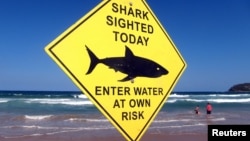A shark alert app has been updated to provide real-time movements of predators off the coast of Australia's most populous state.
The New South Wales government system allows authorities to track sharks that have previously been caught, tagged and released. It follows a spate of attacks on beachgoers last year.
Should a great white shark fitted with an electronic tracker swim into parts of the New South Wales coast, a warning signal will be sent via satellite to a listening station. It will also allow swimmers and surfers with the Shark Smart app to monitor its movements in real time.
The application is part of a range of measures designed to make Australia’s beaches safer, said Niall Blair, New South Wales minister for primary industries.
Informational app
“We have also got education programs like our Shark Smart app, which is to inform beachgoers about what type of conditions they can try and avoid to reduce the risk for themselves," Blair said.
"But we also know that people love going to the beach and it is an emotive issue, so we are not just going to stop at education, we want to look at other technologies and things that we may be able to implement here in New South Wales and we want to lead the nation on this,” he added.
Dozens of predators, including great white and bull sharks, have been tagged so far, while a new eco-barrier to protect beachgoers is also being installed near the tourist town of Ballina, north of Sydney, where there has been a series of attacks in the past 14 months.
A Japanese surfer was mauled to death in the area in February 2015.
Some criticize move
Some surfers, however, have criticized the move, insisting that board riders could become entangled in the plastic barrier. It is designed to stop sharks entering an enclosure for swimmers, but not entrap other marine species, including dolphins and turtles.
Surveillance drones and buoys that use sonar to detect the shape of a shark in the water and are also being tested at popular beaches in eastern Australia.
Researchers say that sharks create a distinctive sonar signature and that their swimming patterns are different to mammals, allowing their shape and movements to be identified.







